
Gene doping.
© 2003 Nature Publishing Group Murray, T. An Olympic tail? Nature Reviews Genetics 4, 494 (2003). All rights reserved. 
One of the first issues that comes up when considering whether, when, and how results from genetic studies will be exploited for gene doping purposes is whether gene doping is "right." While many people agree with WADA's position that gene doping threatens the integrity of sports competition, others think differently. For example, Julian Savulescu, professor of ethics at the University of Oxford, England, argues that "[g]enetic enhancement is not against the spirit of sport; it is the spirit of sport" (Skipper, 2004). Whether or not it is right to use DNA for enhanced athletic performance will likely be a subject of fiery debate for years to come.
The Science Behind Gene Doping
While gene doping has yet to become a reality, H. Lee Sweeney, a professor of physiology at the University of Pennsylvania School of Medicine and one of the leading researchers in the field of gene therapy, has already been inundated with requests for such doping from professional weight lifters and numerous other athletes, according to an article in Science News (Brownlee, 2004). Sweeney has garnered this attention because of his discovery of a way to potentially reverse muscle degeneration caused by diseases like Duchenne muscular dystrophy (DMD), a sex-linked genetic disorder. In patients with DMD, a critical muscle protein called dystrophin gradually becomes dysfunctional over the first few years of an affected person's life, leading to a loss of muscle fiber, an increase in fibrosis, and eventually complete loss of muscle function. Working with a mouse breed that had a mutation in the dystrophin gene and thus displayed a DMD-like phenotype (mdx mice), Sweeney and his colleagues observed that when a protein called insulin-like growth factor 1 (IGF-1) interacted with the cells on the outside of muscle fibers, it caused the cells to grow. In addition, the research team determined that inserting the gene that encodes IGF-1 into muscle cells produced the same effect.
Sweeney and his colleagues further found that when the muscle fibers of mdx mice were exposed to IGF-1, not only did fibrosis decrease as the mice aged, but muscle mass actually increased by about 40% (Barton et al., 2002). Sweeney told Science News that when the mice became the equivalent of senior citizens (which for mice is about 20 months of age), they were still as strong and fast as they had been when they were young. After these and subsequent studies, the IGF-1-endowed mice became known as "Schwarzenegger mice." While groundbreaking, Sweeney's research is still experimental, and the findings have yet to be tested on DMD patients or other humans.
Meanwhile, a group of scientists headed by Ronald Evans of the Salk Institute in La Jolla, California, demonstrated that injecting mice with the gene that encodes a fat-burning protein called PPAR-δ enabled the animals to run up to twice the distance of their wild-type littermates (Wang et al., 2004). Although genetic engineering of these so-called "marathon mice" could potentially be exploited to enhance athletic performance (in long-distance runners or swimmers, for example), Evans's reason for pursuing this line of research was to see whether it might have therapeutic value. Specifically, he wanted to test whether increasing PPAR-δ expression would transform muscle fibers in a way that might protect against obesity and type II diabetes, as previous studies had shown that many obese and type II diabetic patients have fewer type 1 muscle fibers. Evans and his team thus determined that increasing PPAR-δ expression effectively increased the number of type 1 muscle fibers in mice.
















